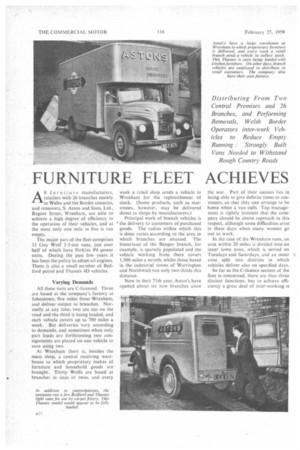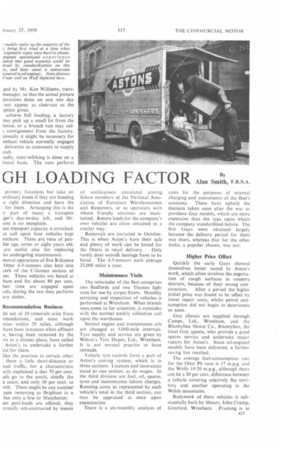FURNITURE FLEET ACHIEVES
Page 58

Page 59

Page 60

If you've noticed an error in this article please click here to report it so we can fix it.
GH LOADING FACTORAlan Smith, F.R.S.A. Distributing From Two Central Premises and 26 Branches, and Performing Removals, Welsh Border Operators inter-work Vehicles to Reduce Empty Running : Strongly Built Vans Needed to Withstand
Rough country Roads
As furniture manufacturers, retailers with 26 branches mainly in Wales and the Border counties, and removers, S. Aston and Sons, Ltd., Regent Street, Vv-rexharn, are able to achieve a high degree of efficiency in the operation of their vehicles, and at the most only one mile in five is run
empty.
The major part of the fleet comprises 33 Guy Wolf 2-3-ton vans, just over half of which have Perkins P4 power units. During the past few • years it has been the policy to adopt oil engines. There is also a small number of Bedford petrol and Thames 4D vehicles.
Varying Demands
All these vans are C-licensed. Three are based at the company's factory at Johnstown, five miles from •Wrexham, and deliver output to branches. Normally at any time, two are out on the road and the third is being loaded, and each vehicle covers up to 700 miles a week. But deliveries vary according to demands, and sometimes when only part loads are forthcoming two consignments are placed on one vehicle to save using two.
At Wrexham there is, besides the main shop, a central receiving ware house to which proprietary makes of furniture and household goods are brought. Thirty Wolfs are based at branches in ones or twos, and every week a retail shop sends a vehicle to Wrexham for the replenishment of stock. (Some products, such as mattresses, however, may be delivered direct to shops by manufacturers.) Principal work of branch vehicles is the delivery to customers of purchased goods. The radius within which this is done varies according to the area in which branches are situated. The hinterland of the Bangor branch, for example, is sparsely populated and the vehicle working from there covers 1,500 miles a month, whilst those based in the industrial towns of Warrington and Northwich run only two-thirds this distance.
Now in their 75th year, Aston's have opened about six new branches since the war. Part of their success lies in being able to give definite times to customers, so that they can arrange to be home when a van calls. Top management is rightly insistent that the company should be above reproach in this respect, although some difficulties arise in these days when many women go out to work.
In the case of the Wrexham .vans, an , area within 20 miles is divided into an inner town zone, which is served on Tuesdays and Saturdays, and an outer zone split into districts in which vehicles deliver also on specified days.
So far as the C-licence section of the fleet is concerned, there are thus three distinct functions, but to achieve efficiency a great deal of inter-working is ged by Mr. Ken Williams, transmanager, so that the actual picture perations done on any one day not appear as clear-cut as the iption given.
achieve full loading, a factory nay pick up a small lot from the house, or a branch van may colconsignment from the factory. sionaliy it might be necessary for exharn vehicle normally engaged deliveries to customers to supply inch.
)adly, inter-working is done on a tional basis. The vans perform primary functions but take on ordinary loads if they are heading e right direction and have the for them. Arranging this is the ;t part of many a transport ger's day-to-day job, and Mr. ims is no exception.
ten transport capacity is stretched, in call upon four vehicles kept rexham. These are vans of penble age, seven or eight years old, are useful also for replacing les undergoing maintenance.
moval operations of five B-licence Otter 4-5-tonners also knit into vork of the C-licence section of eet. These vehicles are based at ham and for about 80 per cent. heir time are engaged upon vats, during the rest they perform ary duties.
Recommendation Business
;ht out of 10 removals arise from nnendations, and most work tales within 20 miles, although have been instances when affluent e, having been removed by the, !rn to a distant place, have called Aston's to undertake a further val for them.
like the position in certain other , there is little short-distance or oad traffic, but a characteristic Isily explained is that 70 per cent. ads go to the south, chiefly the x coast, and only 30 per cent. to )rth. There might be any number ople removing to Brighton in a hut only a few to Manchester. ien part-loads are offered, they ormally sub-contracted by means of notifications circulated among fellow members of the National Association of Furniture Warehousemen and Removers, or to operators with whom friendly relations are maintained. Return loads for the company's own vehicles are often obtained in a similar way.
Removals are curtailed in October. This is when Aston's have their sale and plenty of work can be found for
the Otters in retail delivery. Only rarely does outside haulage have to be hired. The 4-5-tormers each average 25,000 miles a year.
Maintenance Visits
The remainder of the fleet comprises two Bedfords and two Thames light vans for use by carpet fitters. Monthly servicing and inspection of vehicles is performed at Wrexham. When branch vans come in for attention, it coincides with the normal weekly collection call upon the warehouse.
Sternol engine and transmission oils are changed at 5,000-mile intervals. Tyre supply and service are given by Wilson's Tyre Depot, Ltd., Wrexham. It is not normal practice to have retreads.
Vehicle tyre records form a part of Aston's costing system, which is in three sections. Licences and insurances stand as one section, as do wages, In the third division are fuel, oil, spares, tyres and maintenance labour charges. Running costs, as represented by each vehicle's total in the third section, can thus be appraised at once upon examination.
There is a six-monthly analysis of costs for the purposes of internal charging and assessments of the fleet's economy. These have upheld the decision taken soon after the war to purchase Guy models, which are more expensive than the type upon which the company standardized before. The first Guys were obtained largely because the delivery period for them was short, whereas that for the other make, a popular chassis, was not.
Higher Price Offset
Quickly the early Guys showed themselves better suited to Aston's work, which often involves the negotiation of rough surfaces in country districts, because of their strong con struction. After a period the higher initial price was found to be offset by lower repair costs, whilst petrol consumption did not begin to deteriorate so soon.
Guy chassis are supplied through Camps, Ltd., Wrexham, and the Rhostyllen Motor Co., Rhostyllen, the local Guy agents, who provide a good spares service and undertake major repairs for Aston's. Since oil-engined models have been delivered, a further saving has resulted.
The average fuel-consumption rate for the Otter P6 vans is 17 m.p.g. and the Wolfs 19-20 m.p.g., although there can be a 20 per cent, difference between a vehicle covering relatively flat territory and another operating in the Welsh mountains.
Bodywork of these vehicles is substantially built by Messrs. John Crump, Gresford, Wrexham. Framing is in R25 timber with integral cabs and aluminium panelling of generous gauge to provide against striking overhanging branches in country lanes, a prevalent source of likely damage.
At the rear there is no well,'as it is desirable for the tail to be kept clear of the ground. The tailboard forms a loading platform when dropped, and the door is hinged open from the top to make a protective canopy. A recent experiment is the use of one-piece
translucent roofs or clear Perspex roof panels. In the cab two loaders may sit beside the driver.
Mr. Williams rates the chief qualifications of a good driver as driving ability, knowledge of routes, personality and skill in handling furniture —not necessarily in that order. He considers himself fortunate in having a staff three-quarters composed of. long-service employees. Men can gain initial experience in the proper hand
ling of furniture by working in the warehouse.
Although accidents are rare, it has been found prudent to provide drivers with accident-report forms which they may carry with them, and complete with all the information required for the settlement of any claim should a mishap occur. Use of this form has sometimes avoided much protraction of negotiations and has possibly contributed to keeping premiums !ow.




































































































